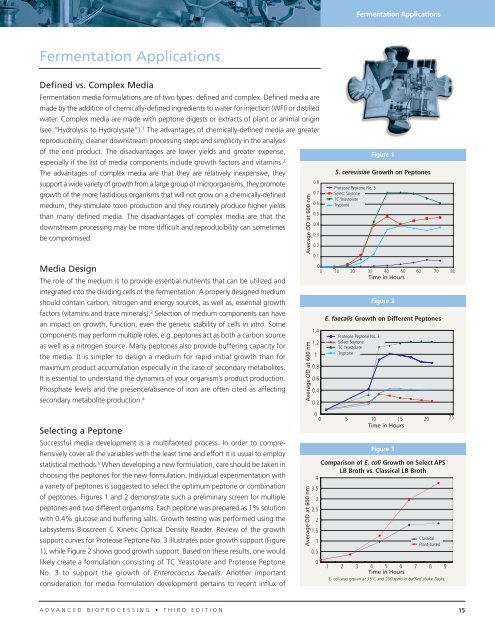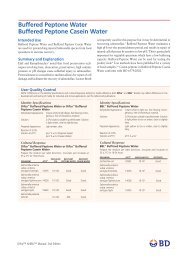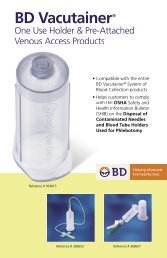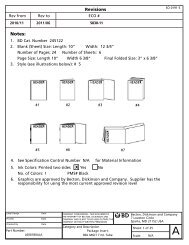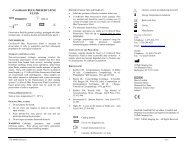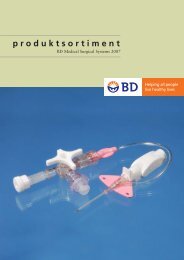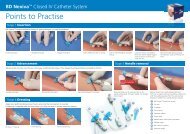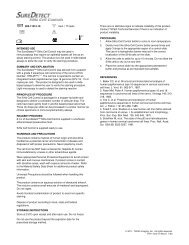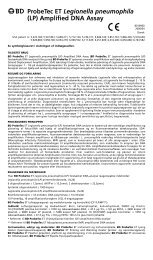You also want an ePaper? Increase the reach of your titles
YUMPU automatically turns print PDFs into web optimized ePapers that Google loves.
Fermentation Applications<br />
Defined vs. Complex Media<br />
Fermentation media formulations are of two types: defined and complex. Defined media are<br />
made by the addition of chemically-defined ingredients to water for injection (WFI) or distilled<br />
water. Complex media are made with peptone digests or extracts of plant or animal origin<br />
(see “Hydrolysis to Hydrolysate”). 1 The advantages of chemically-defined media are greater<br />
reproducibility, cleaner downstream processing steps and simplicity in the analysis<br />
of the end product. The disadvantages are lower yields and greater expense,<br />
especially if the list of media components include growth factors and vitamins. 2<br />
The advantages of complex media are that they are relatively inexpensive, they<br />
0.8<br />
support a wide variety of growth from a large group of microorganisms, they promote<br />
0.7<br />
growth of the more fastidious organisms that will not grow on a chemically-defined<br />
0.6<br />
medium, they stimulate toxin production and they routinely produce higher yields<br />
0.5<br />
than many defined media. The disadvantages of complex media are that the<br />
0.4<br />
downstream processing may be more difficult and reproducibility can sometimes<br />
0.3<br />
be compromised.<br />
Media Design<br />
The role of the medium is to provide essential nutrients that can be utilized and<br />
integrated into the dividing cells of the fermentation. A properly designed medium<br />
should contain carbon, nitrogen and energy sources, as well as, essential growth<br />
factors (vitamins and trace minerals). 3 Selection of medium components can have<br />
an impact on growth, function, even the genetic stability of cells in vitro. Some<br />
components may perform multiple roles, e.g. peptones act as both a carbon source<br />
as well as a nitrogen source. Many peptones also provide buffering capacity for<br />
the media. It is simpler to design a medium for rapid initial growth than for<br />
maximum product accumulation especially in the case of secondary metabolites.<br />
It is essential to understand the dynamics of your organism’s product production.<br />
Phosphate levels and the presence/absence of iron are often cited as affecting<br />
secondary metabolite production. 4<br />
Selecting a Peptone<br />
Successful media development is a multifaceted process. In order to comprehensively<br />
cover all the variables with the least time and effort it is usual to employ<br />
statistical methods. 5 When developing a new formulation, care should be taken in<br />
choosing the peptones for the new formulation. Individual experimentation with<br />
a variety of peptones is suggested to select the optimum peptone or combination<br />
of peptones. Figures 1 and 2 demonstrate such a preliminary screen for multiple<br />
peptones and two different organisms. Each peptone was prepared as 1% solution<br />
with 0.4% glucose and buffering salts. Growth testing was performed using the<br />
Labsystems Bioscreen C Kinetic Optical Density Reader. Review of the growth<br />
support curves for Proteose Peptone No. 3 illustrates poor growth support (Figure<br />
1), while Figure 2 shows good growth support. Based on these results, one would<br />
likely create a formulation consisting of TC Yeastolate and Proteose Peptone<br />
No. 3 to support the growth of Enterococcus faecalis. Another important<br />
consideration for media formulation development pertains to recent influx of<br />
ADVANCED BIOPROCESSING • THIRD EDITION<br />
Average OD at 600 nm<br />
Average OD at 600 nm<br />
Average OD at 600 nm<br />
0.2<br />
0.1<br />
1<br />
0<br />
1.4<br />
1.2<br />
0.8<br />
0.6<br />
0.4<br />
0.2<br />
Proteose Peptone No. 3<br />
Select Soytone<br />
TC Yeastolate<br />
Tryptone<br />
0 10 20 30 40 50 60 70 80<br />
Time in Hours<br />
Proteose Peptone No. 3<br />
Select Soytone<br />
TC Yeastolate<br />
Tryptone<br />
0<br />
0 5 10 15 20 25<br />
Time in Hours<br />
4<br />
3.5<br />
3<br />
2.5<br />
2<br />
1.5<br />
1<br />
0.5<br />
0<br />
Fermentation Applications<br />
Figure 1<br />
S. cerevisiae Growth on Peptones<br />
Figure 2<br />
E. faecalis Growth on Different Peptones<br />
Figure 3<br />
Comparison of E. coli Growth on Select APS<br />
LB Broth vs. Classical LB Broth<br />
Classical<br />
Plant-based<br />
E. coli was grown at 35o 1 2 3 4 5 6<br />
Time in Hours<br />
7 8 9<br />
C and 250 rpms in baffled shake flasks.<br />
15


